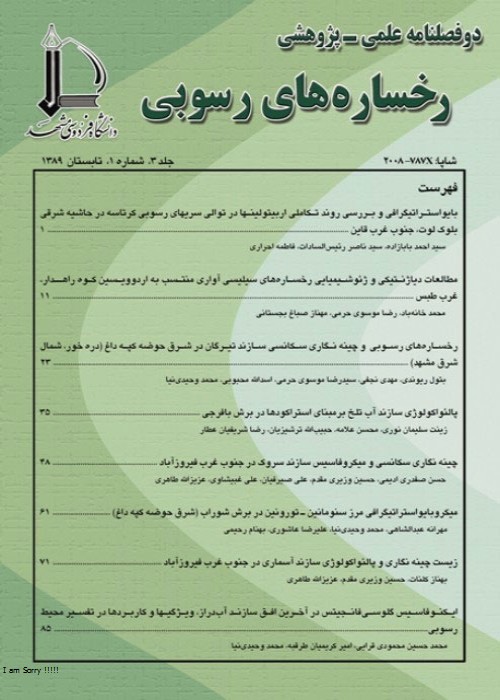Stratigraphy, sedimentary facies and tectonic setting of sandstones of the middle part of the Upper Red Formation at Chehrabad deposit section, northwest of Zanjan
The Upper Red Formation (URF), with the age of Miocene, is mainly composed of clastic sediment including interbedded marl, sandstones and slightly conglomerate layers as well as some evaporate layers mostly in lower parts of the formation. The lithology, color and thickness of this formation are variable in a different locality (Aghanabati, 2004). This formation is the only cap rock for the Qum Formation in the Central Iran zone especially into the Sarajeh and Alborz gas-fields (e.g., Morley et al., 2008). The URF has significant distribution in the northwestern of Iran and hosts significant Cu and Pb-Zn deposits (e.g.; Sadati et al., 2016). The constituents of this formation, particularly in the sandstone layers, provide valuable information in relation to the sedimentary environment and the geodynamic location of this formation (Rieser et al., 2005). In this research, based on the facies analysis (Miall, 1996, 2000), modal analysis and geochemical data, sedimentary environment and tectonic setting of these clastic layers in the Chehrabad deposit section, northwest of Zanjan, are interpreted.
This research is based on a detailed study of lithology, sedimentology and geochemical data of the URF. During field observations, the thickness of sandstone layers and their colors were clearly defined. In order to interpret the sedimentary environments of this formation, a detailed lithofacies have been analyzed during this study. Lateral and vertical variations in all layers have been considered. About 23 thin sections from collected samples are studied by polarizing microscope at the University of Zanjan. In each thin section, the 250-points, based on the Gazzi-Dickinson method, were counted. To investigate the tectonic setting of these sandstones, 9 samples with the least amount of weathering and calcium carbonate were selected for geochemical analyses by XRF methods.
Chehrabad area is located in the northeast of Mahneshan, approximately 75 km, northwest of Zanjan. Rock units exposed in this area belong to the Lower Red, Qom and Upper Red formations. The thickness of the URF in this area is about 980 m and consists mainly of three main units. These units, from bottom to top, consist of evaporate layers, alternation of mudstone and grey to red sandstone and finally mudstone with interbedded gypsum layers with a thickness of 235, 590, and 155 m respectively. The studied sequence is a part of the middle portion of the URF, with 231 m thickness and has the highest amounts of sandstone layers. Based on the field observation, the middle parts of the formation including 7 gray to red color sandstone, which is alternate with the red mudstones. The sandstones in the Chehrabad area are grey to red and have poor imbrication. According to the sorting and roundness parameters of the grains and also the low amounts of clay matrix (less than 5%), these sandstones are perhaps to be mature in terms of texture maturity. Based on the types of sandstone grains and the Folk (1980) classification, the URF sandstones in the study area is classified as feldspathic litharenite to litharenite. Facies analyses, the color of layers, presence of cross-bedding and plant fragments, lack of gravel grains, all represent an oxidized continental environment, such as a fluvial system with a highly sinuous channel (meandering river). Also, the presence of symmetric ripple marks and marine trace fossils indicate that the sedimentation of some parts of this formation has taken place to a tidal condition and most likely close to the coastal environment. In addition, based on field studies and facies analysis, identified lithofacies in Chehrabad area include Fl, Sm, Sh, Sr, Sp, St and Fm. According to the characteristics of each facies and based on the method of Miall (1996), these sandstones were deposited in fluvial and tidal depositional systems. The results of petrography and geochemical studies have been used to interpret the tectonic setting of sandstones in the middle parts of the URF. Based on triangular diagrams of Dickinson and Suczek (1979) (Qt-F-L) and Ingersoll and Suczek (1979) (Qp-Lvm-Lsm and Lv-Lm-Ls), also using binary variables graphs of Bhatia (1983) and Roser and Korsch (1986), the tectonic setting of these sandstones is active continental margins and probably foreland basin.
The URF in the Chehrabad area consists of 3 parts and the thickness of the middle part of this formation is about 231 m, with 7 sandstone layers, which alternation with red mudstone beds. Based on microscopic studies, these sandstones are classified as feldspathic litharenite to litharenite. Based on field evidence and the presence of cross-bedding, plant fragments, lack of gravel grains, symmetric ripple marks, presence of trace fossils and also the type of facies, seven lithofacies (including Fl, Sm, Sh, Sr, Sp, St, and Fm) are recognized. The data obtained from point-count and geochemical studies clearly show that the tectonic setting of these sandstones in the Chehrabad area is an active continental margin.


